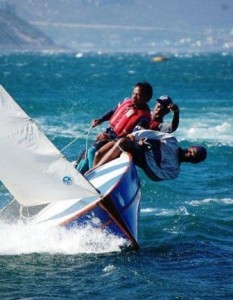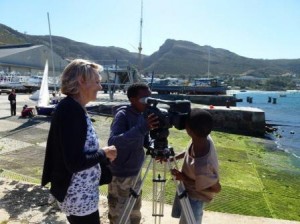Global Ocean Race’s stop over in Cape Town

Izivunguvungu Sailing Club students take over the camera
I joined the Global Ocean Race teams in Cape Town during the stop over after the first leg of the event. It was a good opportunity to talk to the sailors about the work we are doing with them and the race, and to see what information they had collected.
After a well-earned rest and intense preparations, the second leg of the race began on November 29 with Cape Town’s famous noon gun. The yachts are now heading for Wellington, New Zealand, racing through southern Indian Ocean.
Sailing to Cape Town from Palma de Mallorca was challenging with ever-changing conditions, at times frustrating but often very thrilling. While sailing, they were able to collect interesting information for EIA’s Eyes of the Ocean programme, including sightings of swallows and an egret taking a rest on the yachts, pilot whales and dolphins, flying fish, squid and gorgeous albatrosses. The wildlife was exciting but depressingly contrasted with worrying amounts of marine debris, which causes so much havoc to marine species and the ocean ecosystem.
Only a few days into their journey through the southern Indian Ocean and competitors are already reporting encounters with albatrosses, interesting fish and dolphins. One yacht had a southern right whale breaching about 30 metres away; the crew was on close watch to ensure it did not come too close to their vessel.

Izivunguvungu sailors in action
As they sail through the Roaring Forties, they have been asked to document evidence of marine debris if they can. This will make a useful contribution to EIA’s planned briefing on marine debris for the 2012 meeting of the International Whaling Commission.
The highlight of my visit to Cape Town was meeting students of the Izivunguvungu Sailing Club. A group of disadvantaged teenagers are picked up from school every day and given the opportunity learn sailing and boatbuilding skills at Simonstown naval base. At the end of each day, they are provided with a good meal before being taken home. At weekends they may participate in local and national sailing competitions. Participation in the programme requires good behaviour and performance at school and a strong commitment to attending the sailing school.
Simonstown, in False Bay, is often very windy and a howling gale was blowing as the GOR crews arrived for a sailing afternoon with the Izivunguvungu sailors. These tough ocean sailors were rather nervous due to the wind conditions and several ended up in the sea but it was great fun. The Izivunguvungu crews demonstrated remarkable sailing skills in what to them are quite normal conditions.
Not being a sailor by any stretch of the imagination, I was responsible for filming from the dock, joined by several boys who wanted to learn how to use the camera. They were fascinated by following the dinghies through the lens, zooming in and out as they panned across the bay.

EIA Director Jennifer Lonsdale hands over her camera to students of Izivunguvungu Sailing Club
A few days later, the students visited the GOR yachts. They adored exploring these impressive 40ft vessels and talking to the GOR sailors.
I talked to them about the oceans and the need for everyone to do their bit to protect them. These lucky people frequently see whales and dolphins in False Bay and love the sea. I was hugely impressed with their knowledge of environmental issues and we had a fascinating discussion ranging from the impact of marine debris and deforestation to how governments and people must effectively address climate change.
Several of the Izivunguvungu sailors have ambitions to sail in international yacht races and the dream is to have some of them competing in the Global Ocean Race in the future. It is clear many are embracing the opportunities being offered to them through education and sailing, and are fine citizens for the future of South Africa and the globe.

